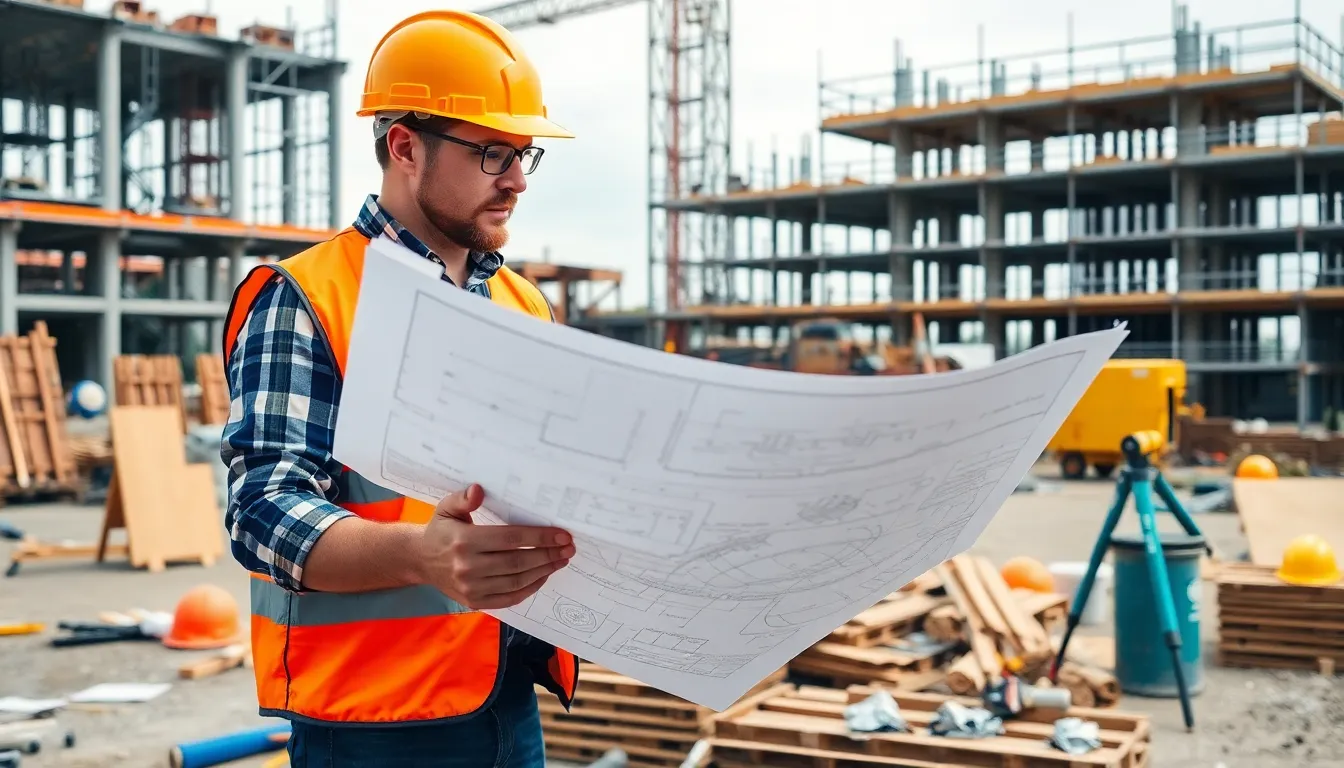Construction blueprints are the unsung heroes of the building world. They’re like the secret recipe for a perfect soufflé—without them, everything might come crashing down. These detailed drawings not only guide builders but also ensure that dreams turn into reality, one wall at a time.
Table of Contents
ToggleUnderstanding Construction Blueprints
Construction blueprints play a vital role in the building process. These detailed drawings provide a roadmap for transforming ideas into physical structures.
Definition and Purpose
Construction blueprints are technical drawings that outline the specifications of a building project. They contain important information, such as dimensions, materials, and locations of structural elements. Architects and engineers create these blueprints to communicate the design intent clearly. Builders and contractors rely on blueprints to ensure accurate execution. Each blueprint serves as a guide throughout the construction phase, facilitating coordination among various trades and professionals.
Types of Construction Blueprints
Several types of construction blueprints exist, each serving a unique function in the building process. Site plans display the arrangement of the structure on the property, including landscaping elements. Floor plans provide a bird’s-eye view of each level, indicating room layouts and measurements. Elevation drawings showcase the building’s exterior, offering details on heights, materials, and finishes. Structural drawings focus on load-bearing elements, ensuring stability and safety. By understanding these types, stakeholders can interpret designs effectively and navigate the construction process seamlessly.
Components of Construction Blueprints

Construction blueprints consist of various components that detail the specifications of a building project. Each type serves a specific purpose in guiding the construction process.
Architectural Drawings
Architectural drawings showcase the design and layout of a building. They include floor plans that display the arrangement of rooms and spaces. Elevation drawings present exterior views, while section drawings illustrate vertical dimensions and structural relationships. These drawings incorporate details such as windows, doors, and materials, ensuring that concepts translate effectively into the final structure.
Structural Drawings
Structural drawings emphasize the integrity and support systems of a building. These documents include information about beams, columns, and load-bearing walls. Detailing the connections and materials used, structural drawings guide the construction of a safe and stable structure. Reinforcement details for concrete elements are also specified, ensuring compliance with safety regulations and construction standards.
MEP Drawings
MEP drawings focus on mechanical, electrical, and plumbing systems within a building. They outline the layout of HVAC systems, electrical wiring, and plumbing fixtures. Diagrams provide critical information about equipment locations and specifications, ensuring functional coordination between various systems. These drawings play a vital role in preventing conflicts and ensuring efficient operation throughout the construction process.
Reading and Interpreting Construction Blueprints
Understanding construction blueprints involves familiarity with various symbols, notations, and measurements. Grasping these elements enables effective interpretation and application during the construction process.
Symbols and Notations
Symbols and notations play a significant role in conveying information on blueprints. Each symbol represents specific elements, such as doors, windows, or electrical outlets. A legend typically accompanies blueprints, explaining the meaning of each symbol, ensuring clarity for all stakeholders. Blueprints also utilize notations to indicate materials preferences and construction methods. Recognizing these markings helps avoid misunderstandings between architects, builders, and contractors.
Scale and Measurements
Scale and measurements establish the dimensions of a building project accurately. Blueprints use specific scales, such as 1/4 inch equals 1 foot, to represent the actual size of structures. Reading and interpreting these scales correctly is crucial for precise execution. Moreover, dimensions indicate critical distances between structural elements and overall project areas. Builders rely on these measurements to ensure components fit together as planned, preventing costly errors on site.
The Importance of Construction Blueprints in Project Management
Construction blueprints play a vital role in ensuring project success and clarity. Their detailed visual representation of designs supports the overall management process.
Legal and Regulatory Compliance
Regulatory bodies require adherence to specific building codes. Construction blueprints incorporate these legal standards, ensuring that projects meet local requirements. Compliance prevents costly revisions and legal issues during construction. Architects and engineers ensure that all aspects align with zoning laws and safety regulations. Having accurate blueprints facilitates obtaining necessary permits, streamlining the approval process and ensuring projects move forward without delays.
Facilitating Communication Among Stakeholders
Communication among stakeholders relies heavily on clear visual documentation. Construction blueprints serve as a common reference point for architects, contractors, and clients. Each party understands the design intent, minimizing misinterpretations. Additionally, detailed drawings clarify roles and responsibilities among crew members, fostering collaboration. Effective communication through blueprints enhances project coordination, leading to smoother workflows and timely completion.
Construction blueprints are indispensable tools that bridge the gap between vision and reality in building projects. They provide a clear framework for all stakeholders involved, from architects to contractors, ensuring everyone is aligned and informed. By mastering the intricacies of these blueprints, builders can navigate the complexities of construction with confidence.
The meticulous attention to detail in these drawings not only enhances project efficiency but also safeguards against potential errors. As the foundation of successful construction management, blueprints foster collaboration and communication, ultimately leading to the timely and successful completion of projects. Embracing the significance of construction blueprints is essential for anyone looking to thrive in the construction industry.









